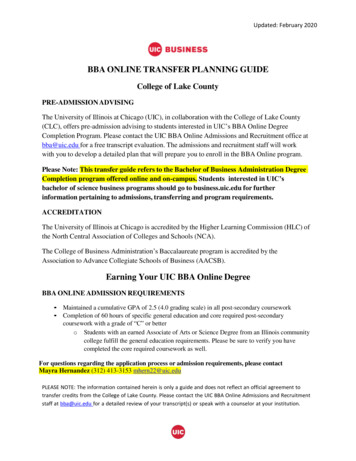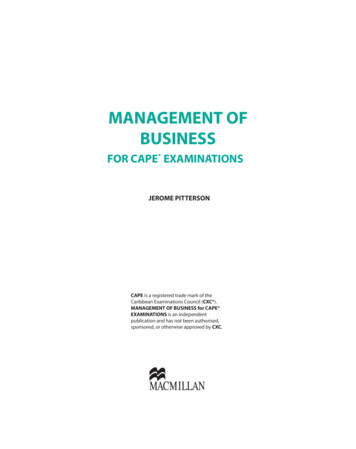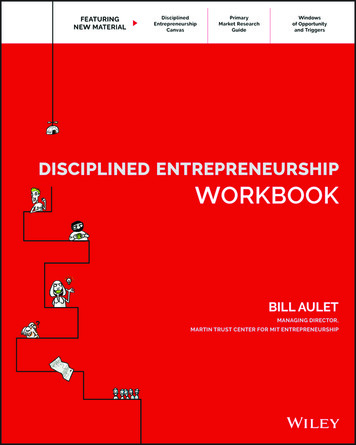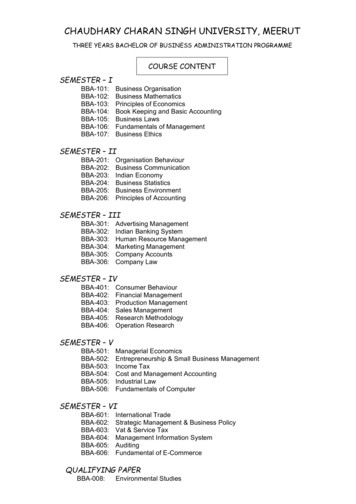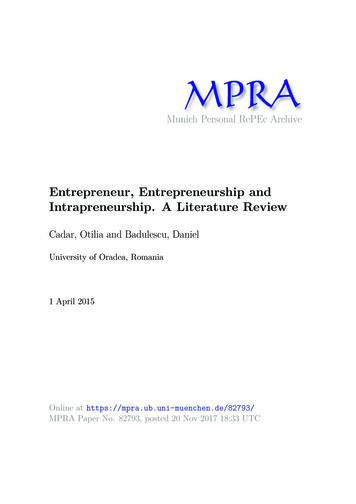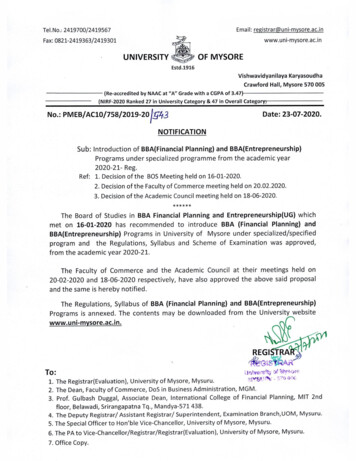
Transcription
BBA (ENTREPRENEURSHIP)ABOUT THE PROGRAM:BBA (Entrepreneurship) program is focused on imparting education and training required to build thenecessary skill set to start up a business. This course aims to guide students desirous of becomingentrepreneurs, be it on their own, as part of an organization or as part of their family businesses. This coursewould help these students acquire practical knowledge about entrepreneurship, build entrepreneurialmentality and familiarize them with tasks that an entrepreneur confronts on a regular basis.Students need to lay as much emphasis upon technical concepts as on the ability to socialize, interact andcommunicate ideas in general. We achieve such critical goals by creating a conductive eco system wherestudents are compelled to work in teams. Our pedagogy specially focuses on practice-based learning.PROGRAM OBJECTIVE: The objective of this BBA Entrepreneurship program is to equip students with all the knowledge andskills they require to start up their venture. Focus of the program is to provide practical real-worldexposure after building a strong foundation through crystal clear understanding of finance andmarketing fundamentals. To improve students’ technical and interpersonal skills for enabling them towork efficiently in their own organization or the corporate world.DETAILS OF FACULTY MEMBERS WITH QUALIFICATION:S.No. NAME1Mr. KushalCFA23QUALIFICATIONEXPERIENCEBhateja, FRM, CFP, PGDBM, B.A. (Eco. More than 11 years of richHons.)experience in various segments ofthe investment industry. Key areasof expertise includes: InstitutionalEquity Sales, Equity Dealing, FixedIncomeMarketAnalysis,Investment Advisory, BusinessDevelopment, Mutual Fund Sales,RelationshipManagement,Financial Planning, InvestmentTraining, and Teaching.Grade A CFPCM from FPSB, Total teaching experience of 23Mr. Dinesh GuptaIRDA,AMFICertified. years and trained professionals fromAssociate in Insurance from all the discipline on CFP modulesInsurance Institute of Indialike Introduction to financialplanning, Risk Analysis andInsurance Planning, RetirementPlanning and Employees Benefit,Estate Planning and AdvanceFinancial Planning.PGDBM (Finance), MA (Eco.), Financial Accounting, ManagementDr. Rishi TapariaB.Com. (Hons.), ICWAIAccounting, Cost & ManagementAccounting, Corporate Finance,Financial Management, InvestmentManagement, Project Appraisal &Finance, Micro Economics, MacroEconomics, Business Environment,Business Statistics
Having around twenty four years ofexperience in teaching, placement,admissionsand other alliedacademic activities. Have also beenvisiting faculty and delivered guestlectures at various managementinstitutions.Haveattended,participated and presented papers atvarious national and internationalseminars and conferences.4Mr. RajeshSinghKumar CA,MBA5Mr. Ashok Jain67Mr. Gaurav ChopraDr. Geetika Batra8Dr. Rishi Mehra9Prof. Ajay MalhotraB.E in Mechanical EngineeringAcademically a finance professionalwith 19 years of experience in theBanking & Financial ServicesIndustry with the likes of ICICI,HDFC, IFCI etc. Has been a Fintechentrepreneur on his own as well as acorporate trainer & business coach.Trading experience of over 40years. Teaching experience of 15years. Developed trading desk forvarious brokerage houses.MBAExpertise in Advanced ExcelCFA,PHD in FinanceTotal experience counts to 8 years.Worked as Assistant Professor(Finance) for 5 years. Specificallyinterested in providing highpremiumknowledgeandcontributing with valuable researchin the field of finance.CFA,MBA,CTM,LIFA(UK)More than 14 years of experience.CEO at Corporate Partners and is anexpert in the area of equity research& derivatives. Have been impartingtraining, Research & consultancy inthe area of finance to corporate andinstitutes. Various Books and CaseStudies have been written in thearea of finance.CFP, MBA.BA. LLB,B.Com(H) More than 16 years of experience inand IRDA certifiedcorporate sector, primarily with IdeaCellular Ltd. Bharti Cellular Ltd. –Airtel, Shoppers Stop and Ebonyretails heading various ons,Newproductlaunches,CRMupgradationandKeyaccount
handlings.10Dr. Geetika BatraCFA with a Ph.D in FinanceTotal experience counts to 8 years.Worked as Assistant Professor(Finance) for 5 years. Specificallyinterested in providing highpremiumknowledgeandcontributing with valuable researchinthefieldoffinance.Interested in pursuing a challengingcareer in the same with a zeal toenhance my knowledge and skills.Specialties: Teaching and mentoringto graduates and post graduatestudents with real time case studymethod, updating curriculum andconductingfinancetraining,research oriented.ASSESSMENT DETAILS APPLICABLE TO ALL SUBJECTS:Assessment Structure:In BBA (Financial Planning) different courses have been divided into three categories:1.Major course: A course which should compulsorily be studied by a candidate as a core requirementtermed as a Major course.Project work/Dissertation work is a special Major/Support course involving application of knowledge insolving/analyzing/exploring a real-life situation/difficult problem.2.Support courses: A Soft-Core course designed to acquire a special/advanced knowledge, such assupplement study/support study to a project work, and a candidate studies such a course on his/her own withan advisory support from a teacher is called a Self-Study Support.Major courses are compulsory whereas Support courses are choice based.3.Elective: An elective course chosen generally from an unrelated discipline / subject, with anintention to seek exposure is called an Elective. Teaching pedagogy for different courses has been as per the L:T:P structure**Every course offered will have three components associated with the Teaching/training-learning process ofthe course, namely Lecture – L (ii) Tutorial- T (iii) Practical/Practice - P, where(i)L stands Lecture session
(ii)T stands Tutorial session consisting of participatory discussion/self-study/deskwork/brief seminarpresentations by candidates and such other novel methods that make a candidate to absorb and assimilatemore effectively the contents delivered in the Lecture classes.(iii)P stands Practice session and it consists of Hands on experience / Laboratory Experiments / FieldStudies / Case studies that equip candidates to acquire the much-required skill component.A course shall have either or all the three components. That means a course may have only lecturecomponent, or only practical component or combination of any two or all the three components.The total credits earned by a candidate at the end of the semester upon successfully completing the courseare L T P. The credit pattern of the course is indicated as L:T:P. Continuous Assessment and Award of Grades**The evaluation of the candidate shall be based on continuous assessment. Assessment and evaluationprocesses will be in a continuous mode. However, for reporting purposes, a semester is divided into 3discrete components identified as C1, C2, and C3. Where C1, C2, C3 may be in the form of test,assignment, project, seminar, presentation, written examination, practical examination etc.The performance of a candidate in each course will be assessed for a maximum of 100 marks.C 1 ASSESSMENTWeightag 25%e%SubTestsAttendancdivision/Presentation es/ProjectUpdate20%5%C 2 ASSESSMENT25%TestsAttendanc/Presentation es/ProjectUpdate20%5%C3(FINAL) tical/Project Submission &Presentation50%
BBA (Entrepreneurship)SEMESTER I101. Introduction to Entrepreneurship:
COURSE OBJECTIVE:The objective of this course is to ignite the spirit of entrepreneurship in the students along with guiding themon the foundation blocks of successful businesses. Student will learn and evaluate different cases exhibitingjourney of Indian businesses, their challenges and how they treaded the uncertain waters and came ourvictorious.LEARNING OUTCOME:On completion of the course student should: Learn about the entrepreneurship mindset and the process;Learn how the idea of the business emerged;What was the opportUNITy; how big was the opportUNITy andWhat was the plan to capture the opportUNITy;What are the challenges faced by start-up firms;Understand what was done by to overcome those challenges and did the steps undertaken by theventures work?Different stages that the new business ventures go throughChange in the business plans and expansion strategiesCOURSE CONTENT:UNIT 1Introduction: Concept and Definitions, Entrepreneurship Mindset, Entrepreneurship process; Factorsimpacting emergence of entrepreneurship; Theories of entrepreneurship; Role of Socio- economicenvironment.UNIT 2Managerial versus entrepreneurial Decision Making; Entrepreneurial attributes and characteristics; Traits /Qualities of Entrepreneurs, Entrepreneurs versus inventors; Entrepreneurial Culture, Entrepreneur as aleader.UNIT 3Classification and Types of Entrepreneurs; Women Entrepreneurs; Social Entrepreneurship; CorporateEntrepreneurs, characteristics of entrepreneur: Leadership; Risk taking; Decision-making and businessplanning.Role of Entrepreneur: Role of an entrepreneur in economic growth as an innovator; generation ofemployment opportUNITies; complimenting and supplementing economic growth; bringing about socialstability and balanced regional development of industries.UNIT 4Creating Entrepreneurial Venture: Generating Business idea - Sources of Innovation, generating ideas,Creativity and Entrepreneurship; Challenges in managing innovation; Entrepreneurial strategy, Businessplanning process; Drawing business plan; Business plan failures.Promotion of a Venture: External environmental analysis- economic, social and technological, Competitivefactors: Legal requirements for establishment of new UNIT and raising of funds, venture capital sourcesand documentation required.
Text Book Hisrich, R.D., Manimala, M.J., Peters, M.P., Shepherd, D.A.: Entrepreneurship, TataMcGraw HillReference Books Young Turks – Inspiring Stories of Tech Entrepreneurs Arise Awake: The Inspiring Stories of 10 young Entrepreneurs who graduated from collegeinto a business of their own, Rashmi Bansal The Underage CEOs, Ganesh V Shankar, R., Entrepreneurship Theory and Practice, Tata McGraw Hill
102. FUNDAMENTALS OF FINANCIAL ACCOUNTING:COURSE OBJECTIVE: To familiarize students with the mechanics of preparation of financialstatements, understanding corporate financial statements, their analysis and interpretation.LEARNING OUTCOME:Student should be able: To understand the basics of financial accounting To learn the preparation of financial statements To understand the objectives of financial statement To familiarize and develop an understanding of the skills of accounting principles for effectiverecording of business operations of an entity To define the function of accountancy in communicating, reporting and assuring financialinformation To explain the contribution and inherent limitations of financial statements in meeting stakeholders’needs for financial informationCourse Contents:UNIT 1Accounting Principles and Processes: Meaning and Scope of Accounting, Accounting Principles, Basic Accounting Terms, AccountingConcepts & Conventions, Journalising Transactions, Ledger Posting and preparation of trial balance,Subsidiary Books: Purchase Book, Sales Book, Purchase Return Book, Sales Return Book, cashBook Bank Reconciliation Statement Capital Expenditure, Revenue Expenditure, Deferred Revenue Expenditure, Capital Profits, RevenueProfits, Capital Loss, Revenue Loss Depreciation: Meaning, Reasons for charging depreciation, Methods of charging depreciation:Straight Line Method, Dimnishing Balance Method Provisions and Reserves Preparation of Financial Statements Accounting Concept of Income Computers and Accounting: An Introduction Accounting in a Computerized EnvironmentUNIT 2Understanding Income Statements Introduction Components and Format of the Income Statement Revenue Recognition; General Principles, Accounting Standards for Revenue Recognition Expense Recognition; General Principles, Issues in Expense Recognition, Implications for FinancialAnalysis Non- Recurring Items and Non- Operating Items Calculation of Earnings per Share; Basic EPS, Diluted EPS, Changes in EPS
UNIT 3Understanding Balance Sheets Introduction: Components and Format of the Balance Sheet Balance Sheet Components: Current and Non- Current Classification; Liquidity- Based Presentation Current Assets and Current Liabilities Non- Current Assets: Property, Plant, and Equipment, Investment Property, Intangible AssetsFinancial Assets, Deferred Tax Assets Non- Current Liabilities Long- term Financial Liabilities; Deferred Tax Liabilities Equity: Components of Equity; Statement of Changes in EquityUNIT 4Understanding Cash Flow Statements Introduction: Components and Format of the Cash Flow Statement Classification of Cash Flows and Non- Cash Activities A Summary of Differences between IFRS and US GAAP Direct and Indirect Methods for Reporting Cash Flow from Cash Flow Activities Linkages of the Cash Flow Statement with the Income Statement and Balance Sheet Steps in Preparing the Cash Flow Statement; Conversion of Cash Flows from the Indirect to theDirect Method Cash Flow Statement Analysis; Evaluation of the Sources and Uses of Cash Common- Size Analysis of the Statement of Cash Flows; Free Cash Flow to the Firm and Free CashFlow to Equity; Cash Flow RatiosUNIT 5Financial Analysis Techniques Introduction: The Financial Analysis Process The Objectives of the Financial Analysis Process; Distinguishing between Computations andAnalysis Analytical Tools and Techniques: Financial Ratios; Common - Size Statements AnalysisText Book Ambrish Gupta, Financial Accounting for Management: An Analytical Perspective, PearsonReference Book T. Horngren Charles, L. Sundern Gary, A. Elliott John, R. Philbrick Danna, Introduction to FinancialAccounting, Pearson R K Arora, Financial Accounting: Fundamentals, Analysis and Reporting, Wiley Narender L. Ahuja, Varun Dawar: Financial Accounting & Analysis, Taxmann S.N. Maheshwari, Suneel K. Maheshwari, and Sharad K. Maheshwari, Financial Accounting, VikasPublishing House Pvt. Ltd. R. Narayanaswamy, Financial Accounting: A Managerial Perspective, PHI Learning Pvt. Ltd CFA Program Level I curriculum – Financial Reporting and Analysis
103. MARKETING MANAGEMENT - I:COURSE OBJECTIVE: The main objective of this course is to give students an elementary knowledge ofthe fundamentals in the field of marketing. The focus will be on developing and helping students understandbasic marketing principles.LEARNING OUTCOME:By the end of the course students should be able to: Identify and relate to the importance of marketing in the success of a company. Describe and analyse the opportUNITies and challenges inherent in marketing environment. Apply product, pricing, distribution and communication strategies to bear positive results.Course Contents:UNIT 1Introduction: Definition of Marketing, Importance and Scope of Marketing, Company orientation towardsthe marketplace, Elements of Marketing - Needs, Wants, Demands, Customer, Consumer, Markets andMarketers; Marketing Vs Selling, Consumer Markets Vs Industrial MarketsDeveloping Marketing Strategies and Plans: Marketing and customer value, Business UNIT StrategicPlanning – The Business Mission, SWOT Analysis, Goal Formulation, Strategic Formulation &implantation, Nature & contents of a marketing planGathering information and Scanning the environment: Components of Marketing Information system,analyzing the macro environment, the demographic environment, other major macro environmentMarket Research: Introduction, Marketing Research processAnalyzing Consumer Markets: What influences consumer behavior?, The Buying Decision ProcessUNIT 2Market Segmentation: Levels of Market Segmentation, Segmenting Consumer Markets, Bases forsegmenting business marketsDealing with Competition: Michael Porter Five Forces Model, Indentifying competitors, Analyzingcompetitors, Competitive Strategies for Market LeadersMarket Targeting – Introduction, Procedure, Product Positioning - Introduction, Objectives, Usefulness,Differentiating the Product, Product Positioning StrategyUNIT 3Marketing - Mix Decisions, Product Decisions, New Product Development-Concept and Necessity forDevelopment, Failure of New Products, New Product Planning and Development Process, Product-Mix,Branding and Packaging Decisions, Product Life cycle - Stages and Strategies for Different Stages of PLC.UNIT 4Pricing Decisions, Pricing Objectives, Policies Methods of Setting Price, Pricing Strategies
Text Book Philip Kotler, Kevin Lane Keller, Abraham Koshy and Mithileswar Jha, Marketing Management – ASouth Asian Perspective, Pearson EducationReference Books Ramaswamy V.S. and Namakumari S - Marketing Management: Planning, Implementation andControl, Macmillian Arun Kumar and N Meenakshi, Marketing Management, Vikas Publishing Philip Kotler, Gary Armstrong, Prafulla Y. Agnihotri and Ehsan ul Haque, Principles of MarketingSouth Asian Perspective, Pearson Education Edmund Jerome McCarthy, William D Perreault, Irwin, Essentials of Marketing Kenneth E Clow, Donald Baack, Cases in Marketing Management, Sage Publications India Syed Saad Andaleeb & Khalid Hasan, Strategic Marketing Management in Asia – Case Studies andLessons across Industries, Emerald Publishing
104. ECONOMIC FUNDAMENTALSCOURSE OBJECTIVE: To help the student in internalising knowledge of microeconomic andmacroeconomic principles. The subject aims to introduce fundamental microeconomic and macroeconomicconcepts relevant to financial markets and investment management.LEARNING OUTCOME: The student is expected to understand the concepts of micro & macroeconomics with perspective tofinance. He/she should understand the equilibrium between demand and supply and concept of elasticity, whichmeasures the rate of changes on the equilibrium price level. He/she should develop the understanding of business cycles, monetary & fiscal policies, internationaltrade and capital flows.Course Contents:UNIT 1Understanding Demand and Supply Calculate and interpret price, income, and cross-price elasticities of demand and describe factors thataffect each measure. Compare substitution and income effects; distinguish between normal goods and inferior goods. Describe the phenomenon of diminishing marginal returns; determine and interpret breakeven andshutdown points of production. Describe how economies of scale and diseconomies of scale affect costs.UNIT 2Firm and Market Structures Describe characteristics of perfect competition, monopolistic competition, oligopoly, and puremonopoly. Explain relationships between price, marginal revenue, marginal cost, economic profit, and theelasticity of demand under each market structure; describe a firm’s supply function under eachmarket structure. Describe and determine the optimal price and output for firms under each market structure. Explain factors affecting long-run equilibrium under each market structure. Describe pricing strategy under each market structure. Describe the use and limitations of concentration measures in identifying market structure. Identify the type of market structure within which a firm operates.UNIT 3Aggregate Output, Prices and Economic Growth. Calculate and explain gross domestic product (GDP) using expenditure and income approaches. Compare the sum-of-value-added and value-of-final-output methods of calculating GDP. Compare nominal and real GDP and calculate and interpret the GDP deflator; compare GDP,national income, personal income, and personal disposable income; explain the fundamentalrelationship among saving, investment, the fiscal balance, and the trade balance. Explain the IS and LM curves and how they combine to generate the aggregate demand curve. Explain the aggregate supply curve in the short run and long run, explain causes of movements alongand shifts in aggregate demand and supply curves. Describe how fluctuations in aggregate demand and aggregate supply cause short-run changes in theeconomy and the business cycle.
Distinguish between the following types of macroeconomic equilibria: long-run full employment,short-run recessionary gap, short-run inflationary gap, and short-run stagflation; explain how a shortrun macroeconomic equilibrium may occur at a level above or below full employment.Analyze the effect of combined changes in aggregate supply and demand on the economy.Describe sources, measurement, and sustainability of economic growth.Describe the production function approach to analyzing the sources of economic growth, distinguishbetween input growth and growth of total factor productivity as components of economic growth.UNIT 4Understanding Business Cycle: Describe the business cycle and its phases. Describe how resource use, housing sector activity, and external trade sector activity vary as aneconomy moves through the business cycle. Describe theories of the business cycle; describe types of unemployment and compare measures ofunemployment. Explain inflation, hyperinflation, disinflation, and deflation; explain the construction of indexes usedto measure inflation, compare inflation measures, including their uses and limitations. Distinguish between cost-push and demand-pull inflation; interpret a set of economic indicators anddescribe their uses and limitations.UNIT 5Monetary and Fiscal Policy Compare monetary and fiscal policy. Describe functions and definitions of money. Explain the money creation process; describe theories of the demand for and supply of money. Describe roles and objectives of central banks; contrast the costs of expected and unexpectedinflation; describe tools used to implement monetary policy. Describe the monetary transmission mechanism; describe qualities of effective central banks. Explain the relationships between monetary policy and economic growth, inflation, interest, andexchange rates; contrast the use of inflation, interest rate, and exchange rate targeting by centralbanks. Determine whether a monetary policy is expansionary or contractionary. Describe limitations of monetary policy; describe roles and objectives of fiscal policy. Describe tools of fiscal policy, including their advantages and disadvantages and describe thearguments about whether the size of a national debt relative to GDP matters. Explain the implementation of fiscal policy and difficulties of implementation. Determine whether a fiscal policy is expansionary or contractionary. Explain the interaction of monetary and fiscal policy.Text Book D N Dwivedi, Managerial Economics, Vikas Publishing HouseReference Books H L Ahuja, Managerial Economics, S Chand Curriculum (CBoK) for CFA Level 1 provided by the CFA Institute, USA Christopher Thomas & S. Charles Maurice, Managerial Economics, McGraw Hill education IC Dhingra, Principles of Microeconomics, Sultan Chand & Sons Gupta G.S.- Managerial Economics, Browning & Browning Samuelson & Nordhaus – Economics, Tata Mc-Graw Hill Publishing Co. Ltd
105. STATISTICS FOR BUSINESS MANAGEMENTCOURSE OBJECTIVE: To help students build an understanding of problem-solving methods, andanalysis, thus enabling them to develop the required skills and apply statistical techniques to decisionmaking problems.LEARNING OUTCOME:Student should be able to: Comprehend different measures of central tendency and dispersion – mean, median, mode, standarddeviation. Understand the concept of normal distribution, skewness and kurtosis. Understand the fundamentals of Probability and Probability Distribution, Sampling and SamplingDistribution Learn Parametric tests, Hypothesis testing, and Non-parametric tests like chi-square tests Learn the concept and application of correlation analysis and regression analysis Learn the basics, fundamentals and methodology of Statistical Quality Control and use of StatisticalDecision TheoryCOURSE CONTENT:UNIT 1Statistics: an Overview: Statistics defined, importance & scope of statistics, limitations of statistics,sources of data, data classification, tabulation and presentationMeasures of central tendency: Arithmetic Mean, Weighted Arithmetic Mean, Median and Mode and theirimplicationsMeasures of Dispersion: Range, Mean Deviation, Standard Deviation, Coefficient of Variation ( C.V.)Skewness, Moments, KurtosisUNIT 2Correlation Analysis: Meaning and types of correlation, Methods of Correlation: Karl Pearson’sCorrelation coefficient and Spearman’s Rank Correlation CoefficientRegression Analysis: Meaning, Methods to determine regression coefficients: Least Squares NormalEquations, Deviations MethodUNIT 3Forecasting and Time Series Analysis: Define Forecast, Types of Forecasts, Timing of Forecasts,Forecasting Methods, Time Series Analysis: Components of time series, Quantitative Forecasting Methods:Time Series Methods – Freehand Method, Moving Averages Method, Trend Projection Method – LinearTrend ModelUNIT 4Fundamentals of Probability: Concept of probability and its uses in business decision-making; Additionand multiplication theorems; Bayes’Theorem and its applications.UNIT 5Sampling and Sampling Distributions: Introduction, Sample Survey, Sampling methods, EstimationTheory, Hypothesis Testing, Introduction and application of Z-test, t-test, F-test and Chi-Square test.Text Book Business Statistics, JK Sharma, Vikas PublishingReference Books Business Statistics, SP Gupta & MP Gupta, Sultan Chand & Sons
Business Statistics, SC Gupta & Indra Gupta, Himalaya Publishing HouseBusiness Statistics, TR Jain & SC Aggarwal, VK Gpyal Publications106. ENTREPRENEURIAL BUSINESS MANAGEMENT:COURSE OBJECTIVE:This subject is intended to provide and insight into the fundamentals of Business and its types. The studentsafter reading this paper will able to understand the different forms of businesses and will able to makedecisions in more judicious way.LEARNING OUTCOME:On completion of the course student should: Know and understand different forms of business organizations and Ownership, their distinctcharacteristics and their merits & demeritsUnderstand importance of planning, planning process and strategies, organizational structure,process of decision making and staffing.Understand motivation concepts and their application, Leadership styles along with meaning, nature,process, requirements of an effective control system.Comprehend the concept and evaluate the business environment, economic trends and role ofgovernment in the economic development and growth.Understand and evaluate the international trade environment and role of international economicinstitutions in the growth of developing countries.COURSE CONTENT:UNIT 1Forms of Business organization & ownership: Sole proprietorship, Partnership & Joint Stock CompaniesPlanning: Nature, Scope and Objective of planning, Types of plans; Planning Process, Process of settingobjectives, MBO, Decision Making FunctionOrganising: Introduction, Formal and Informal Organizations; Orgnaizational Structure, benefits of goodorganizational structure, Determinants of organizational structure, Types of organizational structures, Spanof Control, Delegation of Authority, Authority-Responsibility, Delegation and DecentralizationUNIT 2Directing: Introduction, Principles of Direction, Communication – Importance and Process, InterpersonalCommunication Vs Intrapersonal Communication, Communication process, Communication inorganization, Barriers to communicationStaffing: Introduction to staffing function, Forecasting, Staffing Process, Selection, Performance AppraisalControlling: Nature and Scope of control; Requirements of effective controls, Control Process; Controltechniques – Budgetary Traditional and Non-Budgetary ControlUNIT 3HRM Introduction: Complexities in managing people, HRM – Meaning, scope, objectives, importance,The changing role of HR Management, HRM in India – Evolution, Practices, Growth and obstacles
Acquisition of Human Resources: HR Planning; Job analysis – job description and job specification;recruitment – sources and process; selection process – tests and interviews; placement and induction. Jobchanges – transfers, promotions/demotions, separationsUNIT 4Training and Development: Concept and importance of training; types of training; methods of training;design of training programme; evaluation of training effectiveness; executive development – process andtechniques; career planning and developmentUNIT 5Compensation and Maintenance: Compensation: job evaluation – concept, process and significance;components of employee remuneration – base and supplementary; Performance and Potential appraisal –concept and objectives; traditional and modern methods, limitations of performance appraisal methods, 360degree appraisal technique; Maintenance: overview of employee welfare, health and safety, social securityText Book Harold Koontz, Heinz Weihrich, Essentials of Management, Tata McGraw Hill VSP Rao, Human Resource Management, Excel BooksReference Books Gupta, C.B.; Management Concepts and Practices, Sultan Chand and Sons, New Delhi Dessler, Gary, Fundamentals of Human Resource Management, Pearson Education. Bhushan, Y.K., ―Fundamentals of Business Organisation of Management‖, Sultan Chand & Sons,Latest Edition. Robbins; Fundamentals of Management 9th edition.
107. INOFORMATION TECHNOLOGY APPLICATIONFinal Assessment Pattern (C3 Evaluation): Practical Examination(Course contains the Practical training; therefore C3 evaluation would be done based on PracticalExamination)COURSE OBJECTIVE:Objective of the course is to provide hands on experience to students in using MS Office software forimproving their employability.LEARNING OUTCOME:On completion of the course student should: Demonstrat
Text Book Hisrich, R.D., Manimala, M.J., Peters, M.P., Shepherd, D.A.: Entrepreneurship, Tata McGraw Hill Reference Books Young Turks – Inspiring Stories of Tech Entrepreneurs Arise Awake: The Inspiring Stories of 10 young Entrepreneurs who graduated
